Yikes – you can totally tell summer reading chaos has eaten my life! Back in March I resolved to bring my blog back to life and commit myself to posting regularly. I’ve been doing pretty well with it (and it’s turned out to be much more satisfying than I remembered!) but then, of course, came the SUMMER READING CRUSH and I started to backslide! So, I’m recommitting to my promise to blog. Honestly, I won’t be able to post AS regularly, but I am vowing to still keep posting. IN FACT I am vowing to blog about summer reading! There’s so much about our program changing this year, I want to document it all – what works and what doesn’t.
The first place to start is with READY, SET, READ – a program we launched this summer (two sessions so far) designed to reinvent our storytime offerings for ages 0-6. Our problem was, I am sure, not unique to our library. We had two storytime offerings on Thursday morning: a 0-3 baby storytime we called “wigglers” and a 3-5 storytime we called “walkers”. The problem was, as I am sure you can guess, that these ages got all mixed up and amorphous and we weren’t ever really doing an “older” kid storytime and the older kids were distracting in the baby storytime and on and on. I knew something had to be done … but what?
Let me take a minute here to tell you how my professional life was forever changed by meeting the indescribably inspiring Katie Salo.
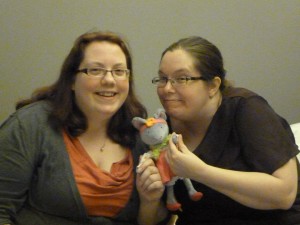 I first met Katie in 2011. (Here we are at Midwinter 2012, hanging out with Kevin Henke’s Penny!) She was, without a doubt, one of the best early literacy librarians I had ever met. She runs the amazing blog Storytime Katie – which if you’re not using as a resource, you’re missing out. The way she approaches storytime was nothing short of revelatory for me. “Whoa,” I thought, “I wish *I* could do that!” It was certainly reinvigorating and through reading Katie’s blog I was introduced to dozens of other amazing and committed early literacy librarians.
I first met Katie in 2011. (Here we are at Midwinter 2012, hanging out with Kevin Henke’s Penny!) She was, without a doubt, one of the best early literacy librarians I had ever met. She runs the amazing blog Storytime Katie – which if you’re not using as a resource, you’re missing out. The way she approaches storytime was nothing short of revelatory for me. “Whoa,” I thought, “I wish *I* could do that!” It was certainly reinvigorating and through reading Katie’s blog I was introduced to dozens of other amazing and committed early literacy librarians.
There’s that.
But it was more than that: it was the fact that Katie is ALSO one of the best teen librarians I know. She’s intimately familiar with YA lit and she runs great programs for her teens.
When I met Katie, I realized that I could no longer say to myself, “Sure, you struggle with the early literacy part of your job, but you’re AMAZING with teens, which is your strength!” I am not a teen librarian – I am a youth services librarian and it is my responsibility to be amazing, innovative, and committed to all my patrons, ages 0-18. And once I saw how good Katie was at both parts of her job? I knew I had to commit to trying to be like her.
My early literacy journey has not been easy! Library service to 7-18 year olds comes easy to me. I can wing it. I can improvise. I can engage easily. I am not afraid, in short. But that 0-6 contingent – oh, I’ve struggled. It takes research, careful planning, reading lots of blogs and professional literature, and asking for lots of guidance and help. But luckily, like Katie, everyone has been more than willing to help and share.
Here are some of the librarians who were (and remain!) the most inspirational to me as I embarked on my early literacy journey:
the many amazing contributors at the ALSC blog
and the countless people I interact, follow, and converse with daily on Twitter, who are always there to offer ideas and encouragement.
With these motivations in place, I decided summer was the perfect time to finally do something about all that storytime overlap, both for the 0-3 year old crowd, who were missing out on their own focused time AND for our older crowd. Using Katie’s Growing Readers and Julie’s Beginning Readers as my inspiration, my library launched READY, SET, READ as a pilot program.

(We’re using an image of a stoplight from ClipArt as the logo – it’s simple to grasp and fits our theme and title.)
In just the two sessions we’ve offered, it’s been a great hit. We’ve had an older crowd both times, age appropriate to what we’ve been advertising and what our focus goal was. I’ve focused on including a longer fingerplay and a short craft, neither of which we do at our 0-3 storytime. I’ve also read longer books, which is such a treat! Here’s a general outline of how the last two weeks have gone and what I’ve learned.
Week 1: Caterpillars
We all arrived and introduced ourselves. Some kids even spelled their names, but I didn’t want to pressure others who might not have all their letters yet.
I talked about how today’s theme was caterpillars and we were going to read stories and sing songs and even make a project about caterpillars. (I also mentioned that we were going to learn new words, which gave some of the older and more developed kids, a chance to immediately shout out CHRYSALIS!!!!)
Our first book was Arabella Miller’s Tiny Caterpillar by Clare Jarrett
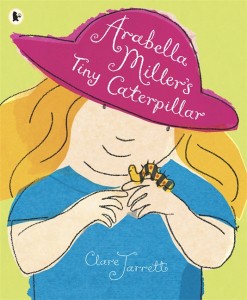
And then we learned the fingerplay for Caterpillar, which I found on YouTube and practiced until I had it memorized! With the help of my student worker, we sang this to the kids a few times and then let them sing along. To encourage parents to keep practicing (and hopefully learn new fingerplays) one of their take homes was a print-out of the lyrics and a way to find the YouTube video.
Then we read our second book: Ten Little Caterpillars by Bill Martin, Jr.
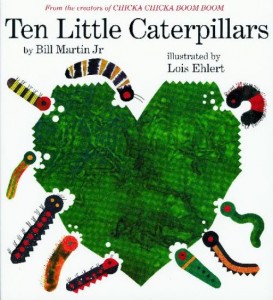
This is a relatively simple counting book, but it was great to read this with an older group because we got to really dig into Ehlert’s awesome pictures and attention to detail in each illustration. We practiced the words for the flowers and animals, I asked the kids to name animals they saw, we talked about how each caterpillar looked, we looked at the other words on the page, we described what each caterpillar was doing.
When our books were done, we did a simple craft that helped me burn through some of our million pompoms!
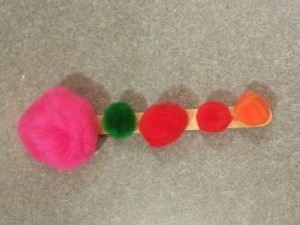
This was a great chance to talk about colors, texture, and sizes and to practice squeezing just the right amount of glue. (The greatest of all challenges for littles!)
We went back to our seats and gave our caterpillars a chance to dry and practice singing the fingerplay a few more times.
The first week was a great success, we had lots of immediate, positive feedback from parents and the kids all seemed to have a great time. All together there were about 14 kids in attendance.
Even though it went well, I still learned lessons for the next time!
Week Two: Apples
Lesson #1: HAVE MORE BOOKS.
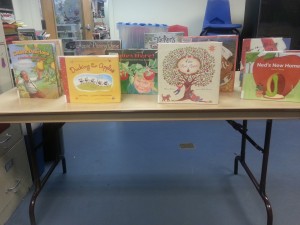
In the first session my mistake was not having enough books for everyone to check out and look at. Also, they make a good decoration: for the kids I think it’s exciting and encouraging to see so many books. So, for week two I made sure we had lots of books about apples and apple pies, including some non-fiction.
Lesson #2: Include a welcoming song. I wanted a firmer way to establish storytime was starting and a song was the perfect choice. Twitter really came through for me, giving me lots of suggestions. I’m not sure I’ll use the same song every time, but it did set the mood.
Lesson # 3: Maybe don’t do a project that needs time to dry. Now this is not to say I won’t ever do another craft with glue, but if I do, I’ll structure the book/fingerplay/craft differently. The caterpillars were still drying when we were done, so that wasn’t the best, timing-wise.
For week two, I followed the same outline. (This time with a welcome song!) We again read a book, did our fingerplay, read another book, and then did our craft.
Our first book was Ducking for Apples by Lynne Berry
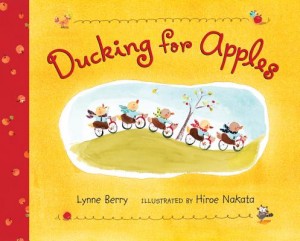
Another fun book to do with an older crowd, lots of talk about rhymes and predicting what words might rhyme next.
Our fingerplay was the classic Two Apples. Using the awesome resources from Hennepin County Library, I again made a handout for take home featuring the lyrics and a way to find the video.
Then we read One Red Apple by Harriet Ziefert.
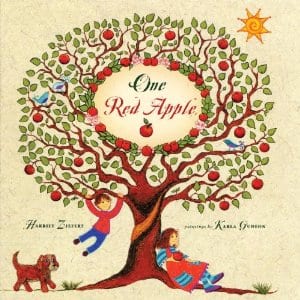
And moved on to our project. This week, I chose to make a mini-book. I found a FREE template on Teachers Pay Teachers (can’t live without it as a resource!) for a mini-book about apples and had our volunteers assemble it. Here’s an example of what our book looked like.
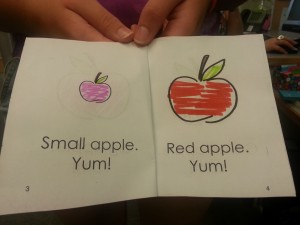
Then the kids each colored their own book. It’s full of simple, repetitive sight words – perfect for the program. I was worried the kids wouldn’t be into this, but they loved it. They loved the sight words and they loved the colors (some colored according to the caption, others didn’t). I heard several kids asking their parents to read them the book and I heard others already reciting some of the sentences. Also, I think this a great, empowering take-home: their own books!
A struggle this week was I chose to move them out of our smaller storytime room to a larger area to color. This was great because it gave them more space to work and encouraged their parents and little siblings to come over and participate too … but it wasn’t so great because it was harder to get them to focus for an official closing and to look at the books we had available. Maybe that’s a trade-off worth making, however, to let them work at their own pace and have lots of room.
We had another good crowd of around 12-14 kids, some returns and some new faces. Of course, I wrung my hands over the kids who didn’t come back (what if they hated the first week??!) but that’s just my nature! I felt, again, like we’d really did something different and important and it was great to connect with and reach out to these older kids.
Now we’re headed into week three! My colleague Melissa will be making her Ready, Set, Read debut and I’m excited to see what she learns and tries and what works and doesn’t. There are so many things I want to try next!
Ready, Set, Read is, for me, a challenge. I have to put in a lot of work with it and I KNOW that I am still learning and will still need lots of guidance and support. But I know I can do it! I know I need to try! I’ve seen the benefits – it doesn’t just make me feel like a better librarian, it makes me happy I’m really addressing a community need. And I know I have an amazing professional learning network – full of librarians like Katie – to show me how it can be done and encourage me along the way.
Do YOU do an early literacy storytime or a similar program? How have you handled the challenges of different ages at storytime? What tips and tricks and lessons of your own do you have to share for any programs geared at this age?
I’m off to learn my next set of fingerplays 🙂 but I can’t wait for the conversation to continue …



Seriously, tears.
It is an indescribable feeling to know how much you inspire someone who inspires you on a daily basis. It’s like the best possible mutual admiration society and I am so glad to know and love you.
ALSO! ALSO!
Pompoms craft!! We have so many pompoms, I have no idea what to do with them all the time!
I have stuck my toes in the Ready, Set, Read program with the parents at the HeadStart center I work at! We did things a little differently than the basic RSR program outlines and even from how we did it the year previous (for one thing, we have a more limited scope — most 3s and 4s with a few 5s) and it was a program for parents on how to encourage prereading and prewriting skills at home. My content area coordinator (essentially my boss’s boss) pared down the program into what I lovingly call a frankenpacket designed to be done in a single workshop, and we touched on several different topics — asking guiding questions while reading (“What do you think will happen next?” etc etc), importance of “prediction” books/a starter reading list, visual/auditory/physical learning styles and different activities that can be done to encourage important preliteracy skills in all of those areas (as well as book suggestions and other resources such as good preschool songs). I think a lot of HeadStart programs are doing RSR in some form in their centers, so you might be able to talk to some teachers there and get even more great ideas! 🙂 (And I think I still have the files saved on my computer with the handouts/notes I made for my workshop, if you or anyone else wants them.)
We still have preschool story hour throughout the year – anyone from infants to kindergartners who go to afternoon kindergarten. It is, as you know, a huge change from 2 years old to 5 years old. (Infants are brought by mothers with preschoolers, but still, I think they benefit just from hearing someone read and being around other children.) Kids love books when they can answer questions: “Are lemons blue?”, or when there is a certain repetitive line. Before the book is done, they are ‘reading’ it with you. Children who are beginning to read during summer story hour like the same things. One set of books that works with children not yet in school and children in very early grades are Mo Willems “Elephant and Piggy” books. At least half of them (and sometimes all of our 15 books or so) are out at once. I also find that I like to read books to grade school tours (especially the early ones) that entertain me. I will often stop and point out certain illustrations that might be in the corner of the page and less noticeable, ask for predictions and so on. The best thing when working with beginning to reads (and those who aren’t) is entertainment. When it’s enjoyable, they will have a greater desire to do it themselves. Oh, and it doesn’t hurt to occasionally read one that’s a little more advanced so they can see where they are headed. (Not to mention familiarize them with more complex sentence structure and vocabulary.) As for the glue, get some glue dots. They are less messy than even glue sticks. They may not work on every single project, but when they do, they are WONDERFUL. And kids love googly eyes!
Katie is awesome!!!! 😀 😀 😀
We’re revamping our programming for preschoolers this fall… Our typical fall/spring registered storytimes have been shrinking for awhile, so we’re starting a weekly “Preschool Time” (which will rotate between Wee Dance (a program heavily focused on music/movement/dancing), Preschool Science, and storytimes) and a weekly Beginning Readers storytime. Some new things for us, but we’re excited to start!